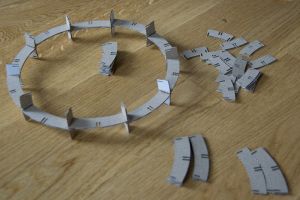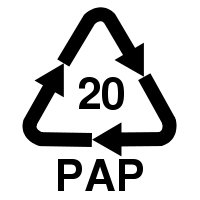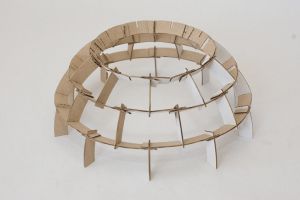GMU:I am a wild type/Projekte/Decaying shelters/In Progress: Difference between revisions
No edit summary |
No edit summary |
||
| Line 14: | Line 14: | ||
Currently I am working on a third prototype that addresses some issues of the second prototype. The third prototype will be usable in a larger scale and allow for an entrance opening. | Currently I am working on a third prototype that addresses some issues of the second prototype. The third prototype will be usable in a larger scale and allow for an entrance opening. | ||
===Semi permanent frame structures=== | |||
A side though I am working on, are semi permanent frame structures to which temporary elements can be added. For example take a basic permanent tent frame to which, at the beginning of summer, a simple piece of fabric is attached and slowly decays until fall. In fall one would attach a more durable skin or build some kind of wall around the frame, in turn slowly decaying until the beginning of summer. | |||
[[Category:Matthias Breuer]] | [[Category:Matthias Breuer]] | ||
[[Category:Dokumentation]] | [[Category:Dokumentation]] | ||
Revision as of 15:40, 15 November 2011
Usually architecture is designed for durability. I want to design architecture that isn't. Taking nature as inspiration I will design dwellings and shelters that completely decay. The idea is to transfer nature's cycle of growth and decay to modern human habitats.
Cardboard dome
The first prototype is a dome made from corrugated paper. The individual parts are being laser cut and can easily be assembled by putting the pieces into each other. The dome can be made in arbitrary sizes.
Corrugated paper is made of 80% recycled paper and biodegrades without residue. The finished dome can be covered with fabrics or other natural materials like straw for enhanced weather resistance and added insulation.
Meanwhile I developed a second prototype with the correct math. This prototype is the base for further experiments in shape and variation. I plan to construct a life sized dome during the semester for testing and to show its versatility. I plan to cooperate with the architecture department for the structural analysis.
The applications for such a structure are countless. The dome shape makes it a very stable self-supporting structure. The lightweight but strong material is easy to transport and set up.
There are many variations for an additional cover I can imagine. The simplest being fabric cut and sewn to the right shape but also filling the gaps with straw and then plastering the outer and optionally the inner wall is possible. Another alternative would be filling the gaps with a compound of straw and soil which then can be be vegetated to create a green roof.
Currently I am working on a third prototype that addresses some issues of the second prototype. The third prototype will be usable in a larger scale and allow for an entrance opening.
Semi permanent frame structures
A side though I am working on, are semi permanent frame structures to which temporary elements can be added. For example take a basic permanent tent frame to which, at the beginning of summer, a simple piece of fabric is attached and slowly decays until fall. In fall one would attach a more durable skin or build some kind of wall around the frame, in turn slowly decaying until the beginning of summer.


